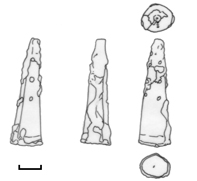The conservator
Back to Urkesh Overview|
The role of the conservator in the excavation is not, as it may seem at first sight, a passive one: it is not only to reconstruct pots and be constantly surrounded by sherds, waiting all day in the lab for objects to repair. Rather, it is an active role which provides advantages both to the conservator's knowledge and to the excavation activities. There are numerous ways in which the conservator can play an important role in the excavation.
It is not always directly concerning restoration: sometimes he/she simply cleans the most delicate objects that are usually too fragile to be brushed by the person responsible for objects in each unit. Even in cases where an experienced specialist can very well do the cleaning by him/herself, the conservator can speed up the process and do some additional work such as consolidating and glueing fragments. The conservator decides if a piece needs stabilization or not and if a piece must be handled with special care. Very often the conservator, together with the other members of the staff, must decide if it is worth spending time in restoring a piece; they evaluate its importance and condition, and keeping in mind that there is often a large number of similar pieces, they decide which piece to treat. |
|
The conservator on the excavation must be flexible and able to work in the field as well as in the lab even with short notice, since there are often “emergency” cases in the field, where for instance a delicate piece must be excavated within a few hours. This is a reason why it is mandatory for conservators to have some field experience, even to know how to move within the excavation. Very often on archaeological digs the conservators are considered simply technicians and are expected to stay in the conservation room all day to glue pieces together; in this way they do not have the feel of the work in the field and how the objects look when they are still in the ground. It is extremely important to create a mutual exchange of information between the needs of the conservator in the field and the expectation of the archaeologist; they do not necessarely always meet, but is important to try. For example archaeologists in Mozan asked the conservator to save a very fragile piece, a burnt wood log, asking that the piece should be lifted as a whole from the ground. However, the conservators, based on practical considerations, indicated that the piece was much too fragile to be lifted. Here the needs of the conservator and those of the archaeologist met and a final solution was found that preserved the objects in the ground but left them in a state where they could be still examined by other experts while in situ. On the other hand there could be a case in which the conservator needs a lot of time to treat an object in the ground before it is removed; this could slow down the digging and could affect the archeologists tempo, but again, cooperation brings out the best solutions for the preservation and documentation of the material excavated.
Back to top Copyright 2003 S. Bonetti |


